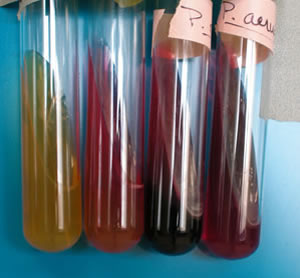This is a differential medium. It tests for organisms’ abilities
to ferment glucose and lactose to acid and acid plus gas end products.
It also allows for identification of sulfur reducers. This media is
commonly used to separate lactose fermenting members of the family Enterobacteriaceae
(e.g. Escherichia coli) from members that do not ferment lactose,
like Shigella dysenteriae. These lactose nonfermenting enterics
generally tend to be the more serious pathogens of the the gastrointestinal
tract.
The first differential ingredient, glucose, is in very short supply.
Organisms capable of fermenting this sugar will use it up within the
first few hours of incubation. Glucose fermentation will create acidic
byproducts that will turn the phenol red indicator in the media yelllow.
Thus, after the first few hours of incubation, the tube will be entirely
yellow. At this point, when the glucose has been all used up, the organism
must choose another food source. If the organism can ferment lactose,
this is the sugar it will choose. Lactose fermentation will continue
to produce acidic byproducts and the media will remain yellow (picture
on the far left below). If gas is produced as a result of glucose or
lactose fermentation, then fissures will appear in the agar or the agar
will be lifted off the bottom of the tube.
If an organism cannot use lactose as a food source it
will be forced to use the amino acids / proteins in the media. The deamination
of the amino acids creates NH3, a weak base, which causes
the medium to become alkaline. The alkaline pH causes the phenol red
indicator to begin to turn red. Since the incubation time is short (18-24
h), only the slant has a chance to turn red and not the entire tube.
Thus an organism that can ferment glucose but not lactose, will produce
a red slant and a yellow butt in a KIA tube (second from the left below).
These organisms are the more serious pathogens of the GIT such as Shigella
dysenteriae.
If an organism is capable of using neither glucose nor
lactose, the organism will use solely amino acids / proteins. The slant
of the tube will be red and the color of the butt will remain unchanged
(picture on the far right below). Pseudomonas aeruginosa is
an example of a nonfermenter.
KIA tubes are also capable of detecting the production
of H2S. It is seen as a black precipitate (second picture
from the right). Sometimes the black precipitate obscures the butt of
the tube. In such cases, the organisms should be considered positive
for glucose fermentation (yellow butt). Proteus mirabilis (pictured
here, second from right) is a glucose positive, lactose negative, sulfur
reducing enteric.
 Kliger’s Iron Agar (KIA)
Kliger’s Iron Agar (KIA)


0 Comments:
Post a Comment